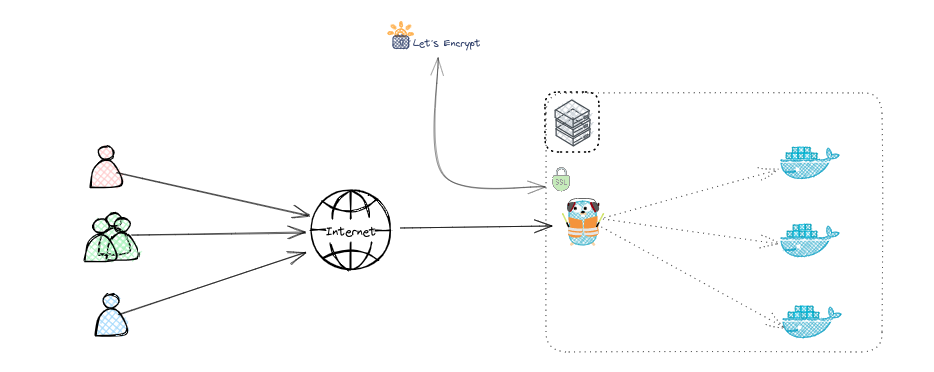Docker-compose with Let's Encrypt : HTTP Challenge
Introduction
This guide provides information on how to set up a simple HTTP-Challenge for Traefik to use Let's Encrypt and certify your domains/websites. We will configure Traefik to act as a reverse proxy for a simple "Whoami" application and secure the app using Let's Encrypt.
Understanding Let's Encrypt: Check this guide.
Overview of HTTP-Challenge
The HTTP-01 challenge is a method used by Let's Encrypt to verify domain ownership. Let's Encrypt requests a specific file to be available at http://your-domain/.well-known/acme-challenge/. Traefik serves this file, and Let's Encrypt verifies its presence to confirm domain ownership.
Difference Between HTTP-Challenge & TLS-Challenge
The HTTP Challenge uses HTTP requests on port 80 to verify domain ownership by serving a specific file at http://your-domain/.well-known/acme-challenge/. The TLS Challenge verifies ownership during the TLS handshake on port 443 by presenting a special certificate, making it more suitable for HTTPS-only environments or when port 80 is blocked.
Prerequisite
For the HTTP challenge you will need:
- A publicly accessible host allowing connections on port
80with Docker and Docker Compose installed. - A DNS record with the domain you want to expose pointing to this host.
Step 0: Configuring DNS Records
Before proceeding, make sure your domain name is correctly configured. Create a DNS A Record that points your domain to the public IP address of your server.
If you don't know what a DNS A Record is, check out this post from Cloudflare.
Step 1: Create ACME File
In this guide, we will store the ACME data in a letsencrypt directory within the folder containing your Docker Compose file. This folder will store your certificates.
mkdir ./letsencrypt
touch ./letsencrypt/acme.json
chmod 600 ./letsencrypt/acme.jsonStep 2: Installing and Configuring Traefik
There are multiple ways to set up your Traefik configuration—either directly in the docker-compose.yaml file or by outsourcing it to external configuration files. Find more information here.
In this setup, we will configure the HTTP challenge for Let's Encrypt directly in the docker-compose.yaml file.
docker-compose.yaml
version: "3.3"
services:
traefik:
image: "traefik:v3.3"
container_name: "traefik"
command:
- "--api.insecure=true"
- "--providers.docker=true"
- "--providers.docker.exposedbydefault=false"
- "--entryPoints.web.address=:80"
- "--entryPoints.websecure.address=:443"
- "--certificatesresolvers.myresolver.acme.httpchallenge=true"
- "--certificatesresolvers.myresolver.acme.httpchallenge.entrypoint=web"
- "--certificatesresolvers.myresolver.acme.email=yourmail@example.com"
- "--certificatesresolvers.myresolver.acme.storage=/letsencrypt/acme.json"
ports:
- "80:80"
- "443:443"
- "8080:8080"
volumes:
- "./letsencrypt:/letsencrypt"
- "/var/run/docker.sock:/var/run/docker.sock:ro"Replace yourmail@example.com with your actual email address and whoami.example.com with your domain name.
Step 3: Integrating Let's Encrypt
You can now integrate automatic certification for your apps by ensuring they are configured with Traefik labels to use the myresolver certificate resolver.
whoami:
image: "traefik/whoami"
container_name: "simple-service"
labels:
- "traefik.enable=true"
- "traefik.http.routers.whoami.rule=Host(`whoami.example.com`)"
- "traefik.http.routers.whoami.entrypoints=websecure"
- "traefik.http.routers.whoami.tls.certresolver=myresolver"Step 4: Starting the Services
Start the services with the following command (only works if your working directory is where your docker-compose.yaml file is saved):
docker-compose up -dYou should now be able to access your Whoami application over HTTPS, secured by a Let's Encrypt certificate.
Conclusion
In this guide, we demonstrated how to set up Traefik as a reverse proxy with Let's Encrypt using the HTTP-Challenge to secure a simple Whoami application. By following these steps, you can apply the same configuration to your own services and ensure secure communication with HTTPS.



No Comments